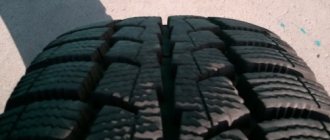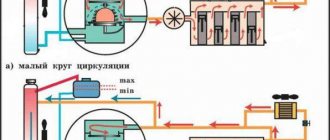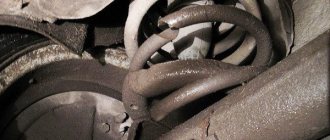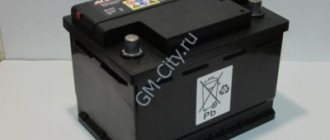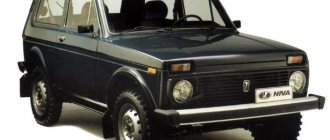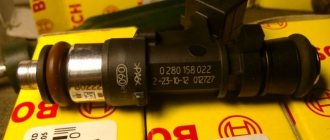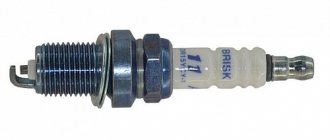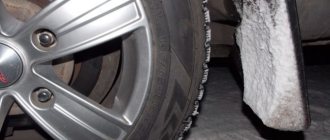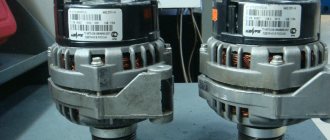| № | Name | Rating | Nomination |
| 1 | HEPU P620 | 4.95 | The most durable |
| 2 | LUZAR LWP0123 | 4.90 | The most popular and accessible |
| 3 | INA 538 0030 10 | 4.85 | The most effective |
| 4 | TZA 2123 POWER CLASSIC | 4.80 | The best pump among domestic ones |
| 5 | Marel MAGNUM MWP005 | 4.75 | The best balance of price and quality |
To replace the pump on a Chevrolet Niva, you do not need to have high qualifications, a pit or an overpass. Some people do it themselves, others trust a car service. But in any case, practical car owners choose and buy the part that needs to be supplied on their own.
Myths about pumps and minor modifications to the cooling system
The everyday life of the pelvis continues, almost every week the car presents a surprise, albeit a minor one, but a breakdown, which motivates me to make modifications and improvements, I hope soon this will not be so often.
1)
For unknown reasons, my pump pulley shattered:
To prevent this from happening again, I decided to change the pump, so I began to study, read and ask the owners a lot. Two popular answers are the TZA pump from the Chevy Niva, supposedly it has a larger diameter impeller, and the HEPU pump, supposedly very reliable. Therefore, let's put everything in order.
2)
Let's take four contestants
— Pump TZA 2123 (Chevy Niva)
It has a plastic impeller, the size of the impeller is actually larger than 2101, but exactly the same as 21213. It differs from 21213 only in a better oil seal and bearing. Price 730 rub.
— Pump TZA 2107 (Marking 2107, expected for NIVA and later sevens)
It also has a plastic impeller, exactly the same in size as 2123, cheaper, sellers explain this with a different filling (oil seal, bearing). Price: 580 rub.
— Pump Luzar 2101 (Marking 2101, suitable for all classic engines)
We have a cast iron impeller and the same size as on the pump for 2123, positive reviews including I am happy with it. But if you have a Niva 21213 or a classic with a mechanical fan drive, this pump is not suitable for you. Due to its design, it is impossible to install a bracket for installing a fan casing on it:
So it’s not suitable for us, even despite the most attractive price for such a device: 670 rubles
— Pump HEPU 2101 (Marking 2101, as well as Luzar, recommend it to everyone)
We have a cast-iron impeller of the same large size as all the competitors, there are no protruding parts like on the Luzar and for some reason everyone praises it, they liked it better than the TZA. Price 730 rub.
Before installation, you need to thoroughly clean everything from the old gasket:
I installed everything without any problems, and also slightly modified my cooling system by installing an 8-blade cooling impeller:
It should cool better, installing a casing ahead.
Conclusion:
TZA pumps may be good, but the plastic impeller does not inspire confidence. If you decide to do so, don’t buy one marked 2101, it has a smaller impeller, even if you have a classic one. Luzar is good, tested in practice, this company generally does everything well, but this protrusion is annoying, you can’t attach the casing anymore, but it helps a lot. The HEPU pump met all my requirements, I recommend it.
Thank you for reading these multi-books, I tried to make a useful entry. Good luck to everyone on the roads!
Source
How to change it yourself?
If you decide to do the work yourself, you will need a new pump for the Niva and a standard set of tools.
Chevrolet Niva is easy to maintain, so replacing the pump yourself will not take much time. You will need:
- new pump with gasket;
- antifreeze for topping up;
- a screwdriver for removing clamps from the cooling system pipes;
- knife for cleaning the pump housing;
- socket or socket wrenches 13 or 17;
- container for draining antifreeze.
It is necessary to place the car on a level surface, turn off the engine and apply the handbrake.
Work progress
Before you begin replacing the water pump on a Niva with air conditioning, you need to drain the excess coolant. If it has already leaked out (which usually happens when the pump breaks down), you can start working right away.
1. Remove the air filter bell;
2. Remove the pipes going to the thermostat and pump;
3. Unscrew the 3 nuts securing the cooling fan;
4. Loosen the 3 bolts securing the pump impeller using a 13mm flat wrench
5. Loosen the generator belt, you need to loosen 3 bolts
6. Loosen the tension with a socket wrench and remove the belt;
7. Unscrew the nuts securing the pulley using a size 13 wrench and pull it out;
8. Unscrew 3 nuts and 1 stud holding the Chevy Niva pump;
9. Remove the water pump, it will be more convenient to do this through the bottom by unscrewing the 2 bolts securing the protection;
Also interesting: The best ball joints for a car
10. Remove the remaining sealant and old gasket with a knife;
11. Apply a thin layer of sealant to the block and the new pump;
12. Install a new gasket;
13. Insert the water pump into its seat; 14. Tighten the stud and fastening nuts; 15. Install the pulley; 16. Tension the generator drive belt; 17. Apply sealant to the thermostat and pump outlet; 18. Put on the pipes and tighten the clamps; 19. Secure the air duct corrugation; 20. Add antifreeze.
Selecting a water pump (pump)
Selecting a water pump (pump)
Post by jurgis8 » Dec 28, 2016, 11:10 pm
Re: Selecting a water pump (pump)
Post by vodila384 » Dec 29, 2016, 00:51
Re: Selecting a water pump (pump)
Post by Yurets 2121 » Dec 29, 2016, 9:47 pm
Re: Selecting a water pump (pump)
Post by Constructor » May 03, 2022, 07:25
I’ll continue here about the pump. Should I change gasket 14 or just tighten the M8 nuts (item 9)?
And maybe something will happen to the gaps between the impeller and the pump body? I read about this bullshit.
Re: Selecting a water pump (pump)
Post by Permyak » 03 May 2022, 11:56
Re: Selecting a water pump (pump)
Post by Constructor » 03 May 2022, 13:12
Re: Selecting a water pump (pump)
Post by Constructor » 02 Oct 2022, 07:50
My beauty has splatter all over the front of her engine. At first I thought that the KV oil seal was breaking through. Replaced it with Corteco. Although, when I already removed the old oil seal, I did not notice that it was the oil seal that was to blame. But if I removed it, I replaced it. Now I'm sinning on the pump seal. I want to replace it. But in the workshop they said that no one deals with such a perversion (replacing the pump seal). Replace the entire cover assembly, along with the impeller. This is true? If so, please send me a link: which one is better to take, what to look/check when buying, how to install (features and subtleties), how to tighten so as not to warp, etc.
Re: Selecting a water pump (pump)
Post by Niver » 02 Oct 2022, 14:45
Source
Communities › Chevrolet Niva › Blog › How to choose the right pump?
Can you tell me which pump to choose? My whole brain was broken... I had a Hepu with a small cast-iron impeller (Zhiguli) - the car was warming up. Replaced it with a TZA (passed the test via SMS), it immediately got loose and a year later when I changed it, the whole impeller was cracked, it would have fallen apart a little. Screw the Luzar on Chevrolet, cast iron - after two years it became noisy, we need to change it to something...
How to choose the right pump so that it does not overheat, so that it does not fall apart and so that it can be bought in a store/bazaar...
Comments 59
Here are the differences between the bearings: Bearings 2101-1307027 and 2108-1307027 are double-row ball bearings, bearings 2123-1307027 and 2110-1307027 are combined (front row roller, rear row ball). The shaft length of the 2101 and 2123 bearing assemblies is 115 mm, and the shaft length of the 2108 and 2110 bearing assemblies is 92 mm. Bearings 2123 and 2110 assemblies are marked “P” on the end of the roller on the side of the roller row; there is also no annular groove “A”. here is another discussion - www.chevy-niva.ru/viewtop…s=0&postorder=asc&start=0
Well, if you think everything is nonsense, you can not read anything and live with your opinion... although the topics are already old...
I know all this, I’m also just as smart...
I’ve had it from Shniva for a long time now...
Are you going to blacklist?))
Read the correspondence - the question is open: what difference does it make where she stands?
you can read the argument here in the last paragraph: www.drive2.ru/c/1050951/#a68926668
I won’t do anything - there is no difference - but there may be consequences - everyone will have their own opinion - I don’t suggest buying Shniv from me! Wait for the opinions of other people...
re-read the topic header, the date and your first comment in this topic - if nothing comes through, then I’m powerless...
and what is it - that I ordered a pump in Thailand? and that a month has passed? so what?
Source
I installed the TZA Powerfull 2123 pump on the field
In the previous topic, I raised the question of which pump to install. The fact is that the last two (Luzar) passed six and five thousand, respectively. Opinions on the topic were divided. Recommended: 1. Hepu 2. Dolz. 3. SKF 4. TZA
Hepu P620. It was my favorite, but I couldn’t find it in stores. The Internet was frightening with reviews that the Hepu p620 can come with impellers of the same size as 2101 and 2123. This means that there are fakes. That’s why I didn’t want to order a pig in a poke. The price to order was about 1250 rubles.
Dolz L127 Dolz was on sale everywhere. But what confused me was that the plastic impeller was pressed onto a round bushing. There are no guarantees against turning it (the same TPAs have grooves). This recording also influenced the choice. By the way, of all the above, Dolz was the cheapest - something around 1100 rubles.
SKF. Out of stock, price for the basin was space.
Well, the old pump didn’t give me any time to think about it. In addition to the bearing play, the car began to heat up mercilessly. In one place it was itching and there was no desire to wait for something to order.
As a result, I took the Powerfull TZA. The first argument in her direction was that it was possible to understand whether she was leftist or not (more on that later). The second is that I bought it from a familiar spare parts department and they said that at least for front-wheel drive they didn’t have a single complaint about these pumps. Well, I also liked the impeller itself. Very similar to a foreign car)) The price, by the way, is the highest of all - 1420 rubles.
So. I found out on the manufacturer’s website that to verify authenticity there must be: 1. A two-color sticker on the box (well, red and black font) + indicators must remain when it is peeled off.
Source
TOP 7 best pumps for VAZ (Lada)
Models from domestic manufacturers are extremely popular among Russian users due to their moderate cost and cheap maintenance. The problem with the machines is their minimal reliability - frequent breakdowns of internal components provoke unscheduled repairs and inspections. In this case, the engine compartment suffers most often. The following is the answer to the question, what is the best pump for a VAZ and how to prevent its early wear.
Correct replacement with the correct pump. Refuting myths.
Greetings to all Niva lovers and those who sympathize with them. A strange thing happened: in Moscow it got colder in winter and snow fell. Naturally, my Niva, pampered by the almost tropical Moscow living conditions, immediately made a statement, which, moreover, did not leave indifferent everyone who parks nearby. Niva made it clear that her fan is quite ready to participate in Eurovision, and is currently learning a hit composition. Not only I didn’t really like the composition, but also my neighbors in the parking lot, who with a sympathetic look said that they were planning to vote for another artist. So I started thinking about replacement options. I didn’t even want to listen about all sorts of luzars, phenoxes, tzas, dolts, hepas, and other nonsense. I think for those who not only drive their cars but also service them, it’s no secret that everything that rotates in the car should have a three-letter name. And it's either INA or SKF. I did not find a pump from INA, and it does not exist in nature. But SKF kindly offered to use their wonderful product VKPC88200
. The product is certainly wonderful, but there are a couple of BUTs. The first is the price. At the time of writing, this crap costs 3,679 rubles on the market. The second thing is that this pump is cheap, so the impeller has a smaller diameter. On the plus side, the impeller is metal, some kind of alloy, not cast iron. Well, I think the most important advantage is the manufacturer itself. I know many owners of European cars that have pumps from this particular manufacturer, and they have driven enough to consider these products reliable. In short, having considered that the main thing is not the price, but the value, I decided to buy. I’ll say right away that the original factory pump has covered 35,000 km, here’s a photo of it
. After a similar attempt to sign up for Eurovision, she was replaced by TZA POWERFULL. Unfortunately I didn’t save the photo. So this TZA drove 37,000 km and I bought SKF to replace it. I consider mileages of 35-37 thousand, provided the belt is correctly tensioned, to be small. This is precisely why the decision was made to supply something that no one would supply because of the price, in the hope of winning in quality. I didn’t intend to follow the path of 97% of Nivavods, who simply unscrew the pump from the body and then insert a new one. Such a replacement is a lottery that is not always possible to win. But in the presence of a cheap impeller, it is not possible a priori. There are very few people who set the gap between the impeller and the housing when replacing. And those who know that it should be no more than 1.2 mm are even smaller. Or better yet, it should be 0.2 mm. Only setting this gap guarantees proper pump performance.
Previously, all VAZ 2101 pumps came with threads inside for adjustment. Using a special puller, the impeller was pulled together to the required clearance, and only then installed in the housing. Over time, manufacturers put more emphasis on this, increasing the diameter of the impeller, the number of blades, and the shape, in order to at least somehow compensate for the decreased performance. According to many “rummaging” nivavods, of which there are large numbers on YouTube, a small “penny” impeller leads to overheating, malfunction of the stove, and the niva going into self-destruction mode. So it is this myth that we will refute. To begin with, with a simple swipe of a bank card, we purchase the following items:
. Next, clamp the SKF pump in a vice and cut the thread. By the way, it cuts very softly.
Source
Design
Classic centrifugal pump of console type. The working shaft, mounted on bearings in an aluminum alloy housing, has a flange on one side for attaching the drive pulley. On the other side, an impeller with curved blades is rigidly fixed to the shaft. Single-row ball bearings, non-standardized, the inner race is the shaft itself, in which the ball raceways are made.
The outer race of the bearings is common, pressed into the housing with an interference fit and is additionally secured with a screw. On the outside, the bearing is protected by a conventional cuff; on the impeller side, an oil seal of a complex design is installed, in a steel cage, with two protective rings. The bearings are lubricated at the factory; replenishment of lubricant is not provided for by the design.
The impeller, depending on the manufacturer, can be made of cast iron, steel or plastic.
The pump pulley receives rotation from the crankshaft through a poly-V belt, which simultaneously drives the generator and power steering. The belt tension is adjusted by a movable roller.
The Chevrolet Niva pump traces its origins back to the water pump of the legendary “penny”, VAZ-2101.
The durability of a critical component, according to the laws of logic, should be close to the service life of the engine itself, but something went wrong in the domestic auto industry. If a “penny” car required engine overhaul no earlier than 130...150 thousand kilometers, and the owner did not even know where the pump was installed, then today’s components do not last that long.
In the vastness and wilds of the Internet you can find a variety of data on the service life of the Chevrolet Niva water pump, from 10 to 80 thousand mileage, but most sources agree: every 60 thousand mileage we change the alternator belt, which means we change the tension roller, and At the same time, we replace the pump if it has not “quacked” before.
The most common reason is failure of the oil seal on the impeller side. Hot, more than a hundred degrees, antifreeze flows into the bearings, washes out the lubricant from them and flows out through the outer cuff. Further events develop like an avalanche - destruction of bearings, shaft misalignment, antifreeze pouring out of the pump body. If the pump shaft gets stuck in the loose balls, the drive belt may break.
It is very rare, but destruction of the plastic impeller and pump impeller occurs. As a rule, this is caused by the use of low-quality coolant. The main component of both antifreeze and antifreeze is ethylene glycol mixed with distilled water and various inhibitor additives. At low temperatures, if the recipe is broken, the coolant turns into a thick mess of ice crystals.
Failure of the impeller oil seal causes coolant to leak from the drive pulley. It is quite difficult to determine a leak visually or by touch; the pulley and the pump itself are well “hidden” under the hood.
It is recommended that, after leaving the parking lot, you inspect the place where the car was parked. Traces of coolant on asphalt or snow can alert the owner to a possible defect. Also, a coolant leak can be prevented by a decrease in its level in the expansion tank.
Working shaft bearings operating without lubrication emit a characteristic noise when the engine is running, which increases as they wear out. Before the “finish”, the squeal of the impeller rubbing against the housing may also be added.
In a working water pump, there is practically no play of the working shaft in the bearings. If, after shaking the pulley with the belt by hand, you find even a slight gap, repairs are urgently needed.
If the impeller is destroyed, the coolant circulation stops, the engine quickly overheats, and the red warning light comes on. Antifreeze in the “water jacket” can boil and tear off the pipes, or squeeze out the head gasket.
Thermostat failure causing similar symptoms is extremely rare. If the thermostat breaks, it is usually in the open position; this is provided for by its design.
In any case, the engine should be turned off immediately and a tow should be sought to move to the repair site.
Repair or replacement?
It is theoretically possible to repair the pump. To do this, it is enough to have a new working shaft assembled with bearings, oil seal, impeller and cuff. Once upon a time, in the days of the Zhiguli, such a repair kit could be “obtained”.
Add a new housing to the listed parts - and you will get a “water pump assembly”, which today can be purchased without any problems in specialized stores.
About choice
AvtoVAZ catalog number: 2123-1307011-75.
It is equipped with a water pump produced by Tolyatti Automotive Units Plant CJSC (TZA).
On the shelves you can also find products from domestic SOATE, Fenox, Pekar. Of the imported ones, they are famous for the quality of products from Hepu (Germany), Graf (Italy), SKF (Germany - Spain).
The cost of a domestic unit starts from 880-900 rubles, imported ones can be found for 1900.
Counterfeit products from various shady manufacturers are very common on the market; outwardly they are practically no different from the original.
- A high-quality pump is packaged in a plastic bag and a bright cardboard box. The packaging must include the catalog number, specifications, Russian and ISO certificate numbers.
- The product kit includes a gasket made of a special material similar to cardboard. A paronite gasket is a sign of a fake!
- It is advisable to choose a pump with a cast iron or steel impeller.
And also interesting: Do-it-yourself Niva 2121 elevator: drawings, dimensions || Lift kit for Chevrolet Niva rating
Work can be performed on any level surface.
From the tool you will need:
- Open-end spanners “13” and “10”. (Better, of course, are sockets with a 50 mm extension and a ratchet, but not everyone has them.)
- Open-end wrenches “7”, for worm-drive clamps.
- Screwdrivers: flat and Phillips.
- Pliers (pliers).
- Actually a new pump with a gasket.
- Antifreeze or antifreeze, depending on what is poured into the cooling system.
- Hose, internal diameter 10 mm, length approx. 0.7 m and a plastic basin.
- Automotive sealant, any.
- A funnel and a piece of nylon stocking.
Unscrew and remove the pulley
We start working after the engine has cooled down.
Attention! The equipment in the engine compartment of the Chevrolet Niva, like any modern car, is arranged quite tightly. Therefore, we work carefully, with minimal damage to ourselves and surrounding components and parts.
- Open the hood and disconnect the negative wire from the battery. Remove the plastic engine cover.
- We remove the corrugated air duct along with the crankcase ventilation hose by loosening the clamps on the throttle valve and air filter and disconnecting the mass air flow sensor wire block.
- To relieve pressure in the cooling system, unscrew it - but do not remove it! – expansion tank plug. We disconnect (for more convenient access) the high-voltage wires by removing the caps from the spark plugs of the 3rd and 4th cylinders. Having placed a basin under the car, we direct the hose from under the hood into it. We turn out the bolt-plug with a “13” head and, pressing the hose to the hole, drain the antifreeze. After filling the basin, screw the plug back in and put the hose and basin aside. We put caps of high-voltage wires on the spark plugs.
The thread for the plug bolt is tapered, so no spacers are required.
If, when the pump broke down, the coolant leaked out and continued to leak out while you were going to the store and preparing for repairs, you don’t need to carry out the operation of draining the coolant. The liter or one and a half remaining above the level of the pump flange will not do much harm; the car is already standing in a puddle. Further:
- Loosen the clamps, disconnect all the hoses from the thermostat pipes, and remove the thermostat. We move the hoses to the side or tie them so that they do not interfere. Disconnect the wiring harness from the electric fan.
- We turn it off with a 13mm spanner - but not all the way! – 3 pulley mounting bolts, pressing the belt with the other hand to prevent the pulley from turning. Loosen the bolts securing the tensioner bar, loosen the belt by unscrewing the tension bolt. At the same time, we count the number of revolutions by which the bolt was turned and write down the number.
- We finally unscrew the bolts by hand and remove the pulley from the pump shaft flange. We do not remove the belt from the remaining pulleys!
- Access to the pump is open. You can finally verify the presence of a coolant leak and unacceptable clearances in the shaft bearings.
- We unscrew the fan mounting nuts (a “13” wrench, the favorite wrench of the Zhigulist and Ladovod!) and push it inside the casing. These 7...10 millimeters may not be enough now!
- Unscrew the nuts from the pump mounting studs. Remove the spring washers. After screwing the nut and locknut onto the lower left stud, we turn out the stud (we will move the pump out to the left and down).
Attention! If your car is equipped with air conditioning, its bracket is attached to the side stud of the pump housing. There is no need to remove the air conditioner assembly; just unscrew the stud using the “nut-locknut” method. When assembling, replace the stud with an M8 bolt of suitable length.
- Having separated the pump from the body, we move it along the three remaining studs to the radiator and remove it, lowering it to the left and down, turning it and bringing it up, between the pipes, hoses and wires. If you have an air conditioner, you can only remove the pump downwards by pushing it between the splash guard and the protection.
Thoroughly clean - with a screwdriver and knife - the mating surface of the housing on the engine block from the old gasket. Wipe all accessible surfaces under the hood from dirt, oil and coolant drips. Dry your hands. Using dry, clean hands, apply a thin layer of sealant to the pump flange, install the gasket on it, align and press it tightly. Apply another layer of sealant to the surface of the gasket - thin but uniform. Dry your hands again and start editing:
- Install the pump onto three studs using the familiar, complicated method. Try not to stain the sealant or move the gasket. Screw in the fourth stud to the full depth of the thread. Place the screws (spring washers), screw on the nuts and tighten them evenly, crosswise.
- Replace the electric fan and tighten its mounting bolts.
- Install the pulley onto the pump shaft flange, screw in and tighten its bolts, holding the pulley with your hand. Place the drive belt on the pulley and tighten it by turning the tension bolt to the number of revolutions you recorded. Tighten the bolts securing the tension roller bar. Hold the pump pulley with a belt and finally tighten its mounting bolts. Connect the fan's wire block to the fan.
Read news about the new Niva
- UAZ or Niva - which is better, car characteristics and features ::
- Tire size for the field, all-season tires for the field 4×4, mud tires, the best winter tires for r16 wheels
- Tires for Niva Chevrolet. Which one to choose?
- TOP 10 best brake pads for VAZ and Lada (Front, rear)
- The best ball joints for a car
- Which battery is better for Niva
- Shock absorbers for Chevy Niva rating
- Tire size for the field, all-season tires for the field 4×4, mud tires, the best winter tires for r16 wheels
Problem
Two issues on the agenda. This is the quality of the product and the re-upholstery of drive belts by the people and Papuans. The court supplier of AvtoVAZ is the TZA plant (Togliatti Automotive Components Plant), which makes truly high-quality domestic products. But the number of fakes is simply off the charts. The Chinese have long since bypassed packaging, holograms and SMS codes on the box. Now the most important protection against counterfeit products is a reliable supplier who works directly with the factory. With the issue of re-tensioning the belts, the picture is sad. In 70% of destroyed pumps: either the belt was too tight or was of poor quality.
Preparatory stage
Like any work related to car repair, replacing a Chevrolet Niva pump should begin with preparing the necessary tools, fixtures and consumables. For repair you will need:
- keys for 13 and 10;
- crosshead screwdriver;
- sealant;
- coolant.
The preparatory stage does not end here. The fact is that the pipe system and thermostat will not allow normal access to the pump, so they will first have to be dismantled.
First, the air duct is removed, disconnected from the throttle assembly and from the air filter housing.
Having opened access to the thermostat, you need to remove all the pipes from it; you can read how to do this here. If the pump replacement was not caused by a fluid leak, then most likely the coolant will begin to pour out when the pipes are disconnected. In this case, you should drain it in advance by any available method. After removing the thermostat, everything is ready to replace the hydraulic pump.
Pump for the field, manufacturer's choice
This spare part is produced by a fairly large number of manufacturers. Hepu, SKF – Germany, NK – Holland, Airtex, Dolz – Spain, Graf, Metelli – Italy, TZA – Russia. There are also several “packers” whose boxes contain other people’s pumps, but we don’t take them into our inventory. The selection of competitors is quite simple; the pump must have a large impeller. Whether it's plastic or metal doesn't really matter. Today, the preferences are as follows: two pumps from the TZA plant and a Metelli pump (supplier of the Fiat conveyor). For a long time, Hepu water pumps had a very good reputation, but apparently cheaper production and globalization had an effect. The service life of products has dropped greatly and for a long time the company name has not been found on body castings. This means that this is all done “outside”. SKF has very good quality, but in terms of price-quality ratio, the pump is very much behind the favorites. The Spanish Dolz are good quality, but unfortunately the pump has a small impeller. However, it can be installed on lightly loaded and not forced engines; no overheating was noticed. On the topic “pump for the field”, a short video was recorded:
Signs of breakdown
Most often, the seal or bearing of the unit breaks. As a result, the pump begins to leak, which can lead to loss of antifreeze or engine seizure. The impeller may also break or break. You can understand that the pump needs replacement by the following signs:
- the characteristic smell of antifreeze vapor in the cabin;
- extraneous noise when the engine is running;
- the appearance of antifreeze drops under the car;
- engine overheating;
- drop in coolant level in the expansion tank.
Pump for the field, TZA
Spare parts from this manufacturer are of very good quality. The only problem is with the heads of the plant “managers” who sell products and set prices. Within a few months, the plant's selling price for pumps increased by 30%. And as soon as the price exceeded foreign competitors, the demand for these products fell again. Idiocy, I can’t think of another word. With such ingenious marketing, no enemies are needed, everything will be ruined with your own hands and head. Let's get back to technology.
Pump for the field, Metelli
I kept this pump in the assortment, primarily “for length of service.” The Metelli concern has always been a conveyor supplier to Fiat, and this means something. The plant that produces the pumps has been producing this product for several decades and has reviews of at least “B” according to the school report card. If we move on to the technical side, then the trump card of this pump is the impeller. Large and “cast iron”. This fact brings ecstasy to the category of nivovods who believe that the plastic impeller will crack, burst and fall apart when exposed to hot antifreeze or antifreeze. I recommend installing this pump only on fields, with a V-belt.
Once again I draw attention to the point of compatibility. Any of the presented pumps can be installed on a classic, Niva or Chevrolet Niva. The only difference is the pulleys and, as a result, the belts.
Source
see also
Comments 21
I bought a pump, it was written on the box 2123. I started installing it and looked at the pump, it was stamped 2101. And there was room for a pin
yes no marking stamped 2123
O. YES! TZA! Took it off my tongue!
Friend, don't listen to anyone! Take the 2107 pump and don’t worry! 1) 2107 pumps 15-17 cubic meters per minute, and 2123 12-14! 2) 2107 costs 700 rubles, and 2123 costs 1500 rubles
So much for arithmetic!
I operate my Chevy in very difficult conditions and constantly suffer from overheating. I installed the seventh pump by accident, at night, since there was no other one in the store... (by the way, this was the 4th pump in a row) and lo and behold! The operating temperature has become lower; when heating up, the second fan almost does not turn on because it does not have time!
good luck off-road!
It’s strange, my classic pump died after 7 thousand. By the way, who is the manufacturer?
dark blue box... DAAZ seems... I've already pumped 30,000! Don't overtighten the belt! just on the verge of whistling!
how many liters of antifreeze do you need?
There’s nothing particularly complicated there. 5 liters of antifreeze is enough with a reserve; I needed exactly 4. you will need to remove the radiator grille unscrew the bolts of the upper radiator mounting remove the air pipe loosen the belt fold back the belt remove the pulley from the pump by the way it is better to loosen the bolts while the belt is tensioned if possible drain the antifreeze into a container (hose funnel and basin) you will also need to check the pipe from the thermostat that goes from the radiator, unscrew the nuts from the studs securing the pump and carefully tapping it with a hammer, shaking it off, I hit it from the side through a chisel. I pulled out the pump just from where the pipe was thrown back. You will need to figure out how the new pump fits without the gasket and remove the old gasket. Lubricate the new gasket with sealant and put everything carefully in place so as not to tear the gasket and reassemble everything in the reverse order. when you fill in the antifreeze, remove the heating hose from the damper (the highest place) and you will be happy. good luck with the replacement!
Take your own Shniv one, the whole difference is in the bearing on the classic ball bearing and on ours the roller one. I changed it twice. And changing it is easy.
By replacing the frames you can
Take HEPU P620 and don’t worry, the part is very well made, large impeller
you need to install the Shniv one - it comes with a tapered bearing as a reinforced one - the rivulet belt puts more pressure on it - don’t make a mistake in choosing - they look the same with a penny!
There are no shniv hairpins
The liquid must be drained, otherwise it will all leak out. But there’s not much of a difference there =) from the radiator the jet hits backwards parallel to the ground, and from the block it’s also parallel to the ground and to the left in the direction of travel. When I changed it I tried to substitute something. As a result, I bathed in antifreeze. The guys were teasing me, they wanted to give me shampoo =) that you’ll spill it like that, that’s it. In the first case less =)
Troubleshooting
The main reason for water pump failure is severe wear of the bearings. Oil seal leakage is also a consequence of worn bearings. Cases when the oil seal began to leak coolant on its own are very rare.
The symptoms of these malfunctions are as follows.
- A suspicious noise is heard in the belt drive area, the intensity of which depends on the degree of wear of the bearings. In the early stages it manifests itself in the form of a hum, and then turns into knocking and grinding. The generator shaft can also make similar sounds - therefore, in this case, additional checking is required.
- There is play on the water pump shaft. You can determine it by shaking the shaft with your hand.
- The belt and the area around the pulley are splashed with antifreeze. This also needs to be further checked - a similar effect is observed when the crankshaft front main oil seal loses its tightness. In the latter case, the front of the engine becomes covered with a layer of oil and dirt.
- With a high degree of wear, the pump shaft moves to the side along with the pulley. As a result, the impeller breaks the housing, the shaft jams and breaks into two parts, and the generator belt jumps off.
If pump problems are not detected in time and the consequences described in paragraph 4 occur, the engine instantly overheats and the coolant quickly leaves the system. In such a case, immediately turn off the engine.
Diagnosing a faulty water pump is quite simple. It is necessary to open the hood and inspect the space around the pulley. If traces of liquid are found, you need to make sure that it is antifreeze and not oil. Then, in order to detect play, you should rock the pump pulley by hand. It should be taken into account that play can occur without coolant leakage through the oil seal. With a small (1–2 mm) play you can drive from 1 to 3 thousand km. After this, repair or replacement of the pump is necessary.
